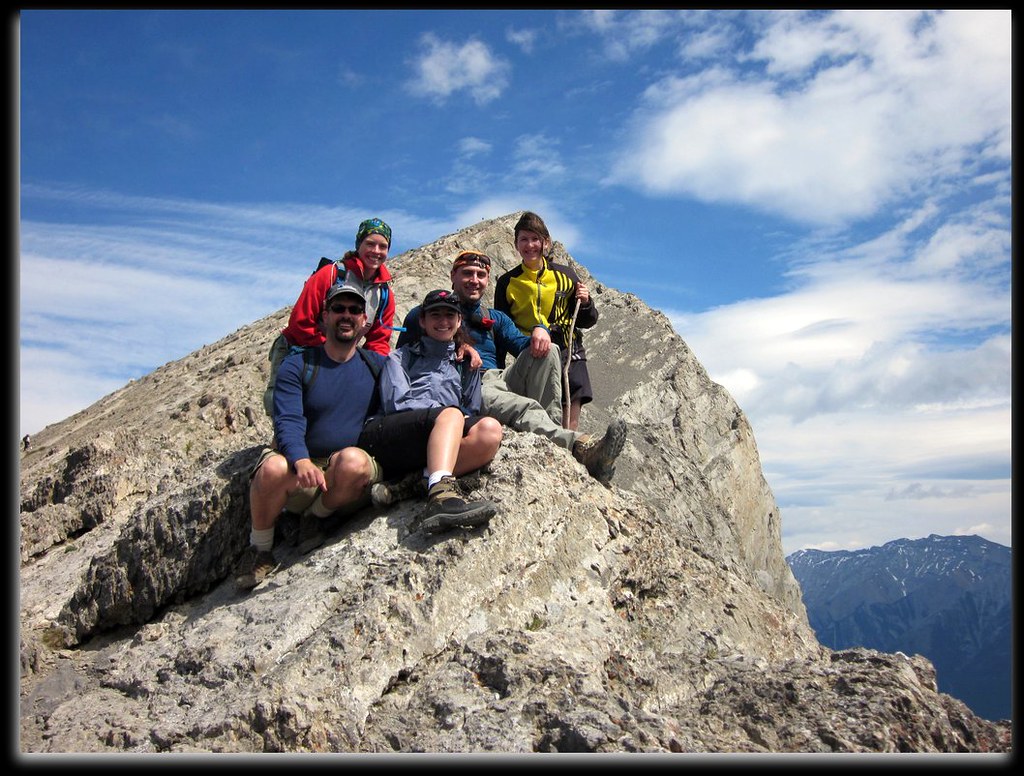Commonwealth Peak
Kananaskia Alberta
August 7, 2011
 |
| Commonwealth Peak as viewed from marsh below |
Commonwealth Peak is located in Kananaskis Alberta, located 45km west on Spray Lakes Road from Canmore.This was my second attempt on this peak. The first attempt was late October 2010 as the team and I looked to take advantage of the low water levels as well as unseasonably warm weather. Unfortunately this ascent came up about 125m short of the summit, stopping at the final gully just below the final upclimb due to abundance verglas and an abrupt turn in weather.
As it turns out, the marsh and braided stream crossings were not that much of an issue, I would however recommend that for people wishing to do this scramble that they bring an extra pair of shoes, or better yet, sandals for the crossing.
We followed the Burstall Pass Trail for about 3km and then descented to the wetland to the right of the trail aiming directly to the drainage between Commonwealth Peak and Piggy Plus. We worked our way through the marsh where the water was only mostly an inch or two deep, however, the braided streams were running well and had water near mid-thigh deep. These were easily jumped across.
 |
| Alpine Meadow |
Once across the marsh we hiked directly into the young trees directly left of the drainage. Up to this point, elevation gain is negligable. The bushwack through the young forest was one of the most dense bushwhacking undertakings that I had done. A note for the future is to stay to the left of the young forest and start the climb through the mature trees where underbrush is much more sparse.
After about an 30 minutes of bushwacking that felt like a lot more, we found ourselves in an alpine meadow filled with the marvelous colours of wildflowers and a few bunblebees. We decided that this was a reat place for a foodéwater break and not being in a hurry spent time admiring nature. After a relaxing rest and several pictures, we continues upwards and quikly found ourselves above the treeline and staring a scree slope dead on. Thankfully there was still some snow patches lingering on this ascent that added a nice change from the constant plodding up the scree. An intesting feature of this scree slope was the abrupt change in scree color running directly up the middle.
 |
View from Commonwealth Col. Robertson Glacier between
Mt¸. Robertson and Mt. Sir Douglas dominate middle of frame. |
After plodding up the scree slope we ended up at Commonwealth Col. Upon turning around we saw what was arguably the most awe-inspiring view you can see in the Burstall Pass area. Looking towards Mt. Robertson and Mt. Sir Douglas we were presented the Robertson Glacier in all its glory, including the alluvial outwash plain. We decided that this was a great scenic place for a refuelling pit stop and quick;y forgot about the scree we just cam up.
Upon leaving the col we headed up a gully that was not surprisingly, filled wih more scree and in some places scree on slab We donned our helmets and stayed close to the cliffs as we worked our way up. As this gully turned left and continued up, it became much more narrow and the scree deeper and more loose. Most of us at this point decided climbing up the rocks to the left and negotiating the rock spine was easier the the 2-step forward 1-step back scree plod. This final gully lead to the bottom of a 15m near-vertical upclimb which spits you out on the summit ridge.
 |
| 15 metre climb to summit ridge |
We tackled this climb one at a time making sure to be very vocal when rocks were knocked down (it was quite loose in locations). We had our two strongest climbers bookend the rest of the team on the way up in case some people found it daunting. Overall there were no difficulties climbing this last section, minus some rockfall, which is also why we staggered our climbs.
Once on the summit ridge, it was about a 2 minute walk to the actual summit. Eventhough this isn`t a major summit, the view is exceptional. I would rank it as one of the best that you get overall in the area. When we arrived at the summit and opened the register we found that this really isn`t a popular peak,and the register is the original one left by Alan Kane in 1997. It is sad that this peak is often overlooked however crossing and all the scree we can understand why.
This mountain is definately worth a revist in the near future.
 |
| Narrow gully |
 |
| Summit Ridge |
 |
| Close-up of up climb |
 |
| Our summit registry entry |
 |
| Summit Shot |
 |
| Alan Kane register entry |
 Paget Peak is located a few kilometres east of Field BC (about 200km north west of Calgary) and just south of the Continental Divide. It occupies the position at the southern end of the Mount Daly Range and is located directly west of Mt. Bosworth. Paget Peak also houses one of the first fire lookouts in Canada's national parks system, and that lookout is still there, and it is the trail to this lookout that takes you 3/5 of the way to the summit.
Paget Peak is located a few kilometres east of Field BC (about 200km north west of Calgary) and just south of the Continental Divide. It occupies the position at the southern end of the Mount Daly Range and is located directly west of Mt. Bosworth. Paget Peak also houses one of the first fire lookouts in Canada's national parks system, and that lookout is still there, and it is the trail to this lookout that takes you 3/5 of the way to the summit.








































